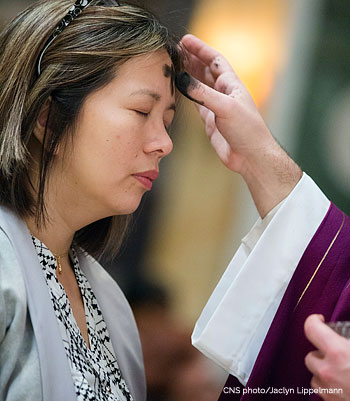Official Website of the
Catholic Diocese of Little Rock
Ash Wednesday
Wednesday, Feb. 22, 2023
Location: All Parishes
Contact: Your Parish for Mass Times
We list regular, weekly Mass times on this website. We do not list special Mass times. To find an Ash Wednesday Mass in your area, click on the button above to visit the website for a parish near you to find Ash Wednesday Mass times. Confirm schedule by calling the parish office.
Ash Wednesday begins our Lenten journey toward the celebration of Easter. Though it is not a holy day of obligation, it is a day of fast and abstinence. We are marked with ashes, in the form of a cross, on our forehead on Ash Wednesday. Why? Bishop Erik Pohlmeier, former diocesan director of faith formation, said the prayer offered as ashes are given answers this question. "The words are a reminder of our origins, 'Remember that you are dust, and to dust you shall return.' The ashes and the whole season of Lent are a time to refocus on our relationship with God and that relationship starts with a dependence on God for our very existence."
"To recall that only with the breath of God can we have life is motivation to reorder whatever part of life needs it. As God breathed life into the dust at the beginning he can breathe new life into those who have fallen into sin," he added. "The ashes are a sign of mortality and a sign of renewal in Christ." Learn more in our Lenten Q&A. The Old Testament offers several examples of how we have a long tradition of using ashes as an "outward sign of grief, a mark of humility, mourning, penance and morality," according to Our Sunday Visitor. (See Job 42:6, Daniel 9:3, Jonah 3:6 and 1 Maccabees 3:47.)
 "Ashes were imposed on the early catechumens when they began their preparation time for baptism. Confessed sinners of that era were also marked with ashes as part of the public penitential process. Other baptized Christians began asking to receive ashes in a manner similar to catechumens and penitents," according to Our Sunday Visitor. "Christian men had ashes sprinkled on their heads while ashes were used to trace the cross on the forehead of women. ..."
"Ashes were imposed on the early catechumens when they began their preparation time for baptism. Confessed sinners of that era were also marked with ashes as part of the public penitential process. Other baptized Christians began asking to receive ashes in a manner similar to catechumens and penitents," according to Our Sunday Visitor. "Christian men had ashes sprinkled on their heads while ashes were used to trace the cross on the forehead of women. ..."
"During the papacy of St. Gregory the Great, the practice was further expanded and is mentioned in the sixth-century Gregorian Sacramentary. Around the year 1000, Abbot Aelfric of the monastery of Eynsham, England, wrote: 'We read in the books both in the Old Law and in the new that men who repented of their sins bestowed on themselves with ashes and clothed their bodies with sackcloth. Now let us do this little at the beginning of our Lent, that we strew ashes upon our heads, to signify that we ought to repent of our sins during the Lenten feast' (“Aelfric’s Lives of Saints,” 1881, p. 263). This same rite of distributing ashes on the Wednesday that begins Lent was recommended for universal use by Pope Urban II at the Synod of Benevento in 1091." Learn more.
Like the early Christians who asked to receive ashes, this practice remains popular among the faithful today. Although Ash Wednesday is not a holy day of obligation, many people line up to receive their ashes each year. Why? Father Tom Gibbons, CSP, tackled this question in a column he wrote for Busted Halo.
"Ash Wednesday understands that when we only think about life, we tend to think about what we want to do, our likes and dislikes, etc. When we think about life, we have the tendency to think about who we are," he wrote. "But when we also consider death, we have a tendency to think about whose we are — that in the final analysis we belong to someone much, much larger than ourselves. ... We are called to something larger in the way we serve and love God and in the way we serve and love one another."
The Lenten season offers us the help we need to remember whose we are. It offers us the chance to start anew. That no matter how long it is has been or what we have done, the Lord calls us to come to him. "Even now, says the LORD, return to me with your whole heart." (Joel 2:12) Even though Lent is somber in nature, there should be no fear in our repentance because it is the first step toward the joy and the new life offered on Easter Sunday.
Father Steve Grunow of Word on Fire explains that it does require humility to receive the ashes because these publically mark us as sinners. "What we know privately about ourselves we show to the world. But that we are sinners is not the only truth that we display. The mark of ashes is a sign to the world that we have received something extraordinary and undeserved from the Lord Jesus. What have we received? A word of forgiveness that is creative, living and effective, which if accepted, gives to us and to the world, what we need most — the gift of a new start and the unexpected grace of another chance."
“We are entering, today, upon a long campaign of the warfare spoken of by the Apostles: 40 days of battle, 40 days of penance. We shall not turn cowards, if our souls can but be impressed with the conviction that the battle and the penance must be gone through. Let us listen to the eloquence of the solemn rite, which opens our Lent. Let us go whither our mother leads us, that is, to the scene of the fall.” — Servant of God, Abbot Dom Gueranger, OSB, “The Liturgical Year: Septuagesima”, 1909




